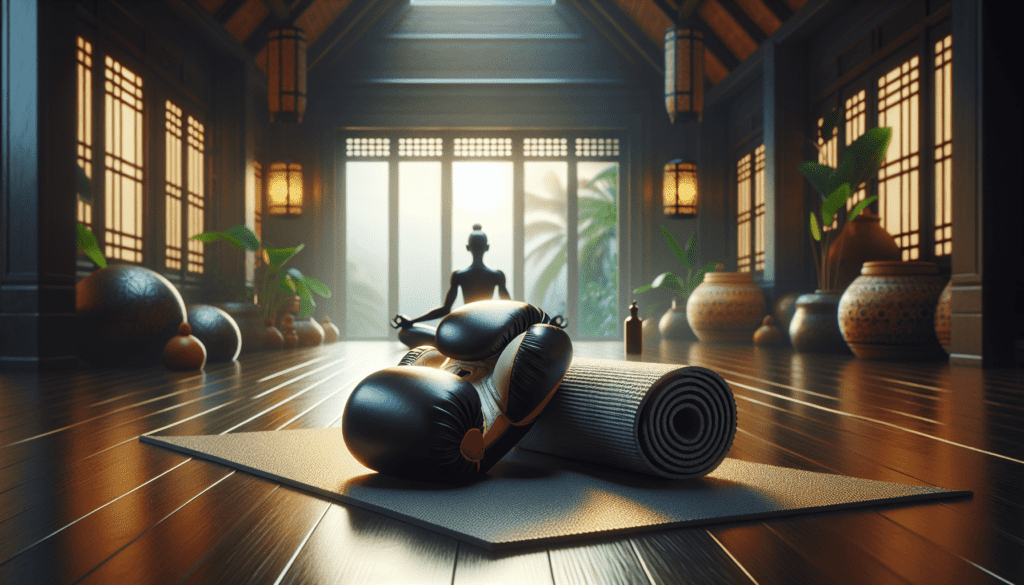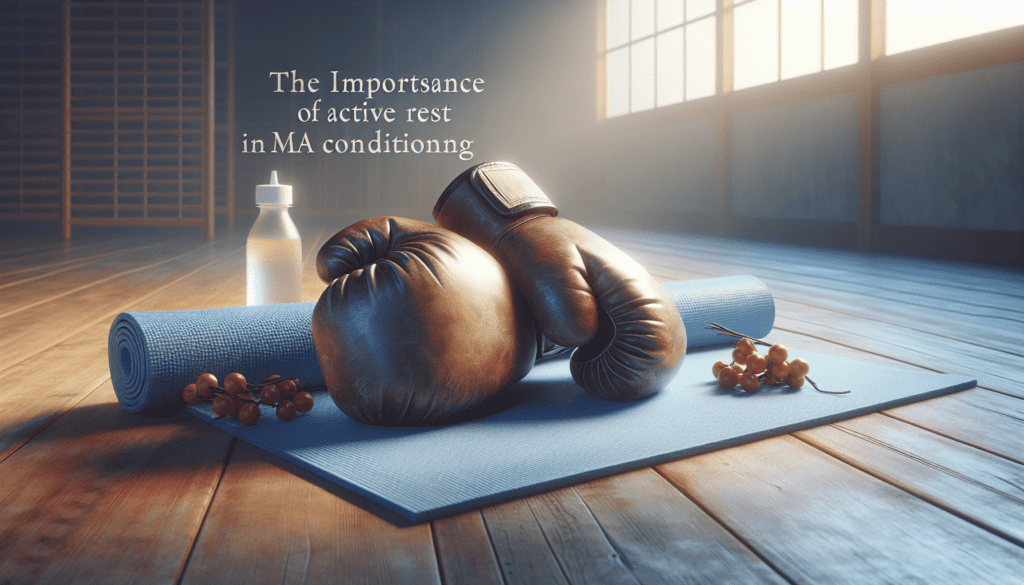“The Importance of Active Rest in MMA Conditioning” explores how integrating active rest into your training routine can significantly enhance your overall performance and recovery as an MMA athlete. You’ll discover how light, purposeful activities like yoga, stretching, and easy cycling can help you avoid burnout, reduce the risk of injury, and maintain your conditioning at peak levels. By learning to balance intense workouts with active rest, you’ll stay energized, agile, and ready to face each bout with renewed vigor.
The Importance of Active Rest in MMA Conditioning
Have you ever wondered what separates an elite MMA fighter from the rest? Is it raw power, lightning reflexes, or relentless endurance? While all these attributes are critical, there’s one often-overlooked aspect that can significantly elevate a fighter’s performance: active rest. If you’re striving to take your MMA conditioning to the next level, understanding and incorporating active rest into your routines could be a game-changer.

The Concept of Active Rest
Active rest isn’t about lounging on the couch with a snack. It’s a strategic approach to recovery that involves low-intensity exercises to aid muscle recovery, boost circulation, and reduce fatigue. This method ensures that you stay mobile and flexible while your body recovers from intense training sessions.
What is Active Rest?
Active rest involves activities that keep you moving but at a much lower intensity compared to your regular training. Examples of active rest activities include light jogging, swimming, yoga, or even a brisk walk. The idea is to stay active without placing additional stress on your body.
| Activity | Intensity Level |
|---|---|
| Light Jogging | Low |
| Swimming | Low |
| Yoga | Very Low |
| Brisk Walk | Very Low |
How Active Rest Benefits MMA Fighters
Active rest isn’t just about keeping you busy. It’s a tactical approach that provides multiple benefits tailored to the rigorous demands of MMA.
Enhanced Muscle Recovery
After an intense MMA training session, your muscles need to repair and grow stronger. Active rest facilitates this by promoting blood flow, which brings oxygen and nutrients to sore and fatigued muscles. Enhanced muscle recovery means less soreness and faster readiness for your next training session.
Reduction of Muscle Soreness
Delayed Onset Muscle Soreness (DOMS) can affect your performance in subsequent training sessions. Active rest mitigates this by flushing out lactic acid build-up and other metabolic wastes from your muscles.
| Active Rest Exercises | Benefits |
|---|---|
| Light Jogging | Enhances blood flow |
| Yoga | Improves flexibility |
| Swimming | Reduces impact on joints |
Increased Flexibility and Mobility
In MMA, flexibility and mobility can make the difference between clinching victory and facing defeat. Active rest activities like yoga and swimming emphasize stretching and full-range-of-motion movements, keeping your joints and muscles limber.
Psychological Benefits
The rigors of MMA training don’t just affect your body; they take a toll on your mind too. Active rest, especially through practices like yoga, can provide a mental break, reducing stress and resetting your focus.
Prevention of Overtraining
Overtraining is a common pitfall for many athletes, including MMA fighters. It can lead to a decrease in performance, increased risk of injury, and even burnout. Active rest allows you to balance your training load, ensuring that you don’t push your body beyond its breaking point.
Signs of Overtraining
Recognizing overtraining early can prevent serious setbacks. Here are some common signs:
- Persistent fatigue
- Recurrent injuries
- Insomnia or disturbed sleep
- Decreased performance
- Loss of appetite
Balancing Training and Rest
Creating a balanced training regimen that includes active rest days can help you avoid the pitfalls of overtraining. A common strategy is to alternate between high-intensity workouts and active rest sessions.
| Day | Activity |
|---|---|
| Monday | High-Intensity Training |
| Tuesday | Active Rest Yoga |
| Wednesday | Sparring Session |
| Thursday | Light Jog & Mobility |
| Friday | High-Intensity Training |
| Saturday | Swim & Stretch |
| Sunday | Complete Rest or Walk |
Improved Cardiovascular Health
Engaging in low-intensity activities can help improve cardiovascular health without the strain of high-intensity training. This is particularly beneficial for MMA fighters, who need peak cardiovascular performance to sustain rounds of combat.
Heart Rate Management
Active rest helps in managing your heart rate better by training your body to recover faster between high-intensity efforts. This is crucial in a sport where quick recovery can mean the difference between winning and losing.
| Heart Rate Zone | Activity Examples |
|---|---|
| Zone 1 (50-60% MHR) | Light Jogging, Brisk Walking |
| Zone 2 (60-70% MHR) | Swimming, Slow Cycling |

Enhanced Sleep Quality
Quality sleep is essential for recovery and performance. Active rest can improve your sleep patterns by reducing stress and balancing your physical exertion levels. Yoga and stretching before bed are excellent ways to promote better sleep.
Types of Active Rest That Promote Sleep
- Light Yoga: Focuses on deep breathing and gentle stretching.
- Meditative Walking: Combines physical activity with mindfulness.
- Swimming: Provides a full-body workout that is both relaxing and low-impact.
The Role of Nutrition in Active Rest
Nutrition plays a crucial role in how effective your active rest will be. Proper refueling with the right nutrients can enhance recovery and prepare you for your next intense training session.
Importance of Hydration
Staying hydrated is vital for effective active rest. Dehydration can slow down recovery and reduce performance.
Nutrients to Focus On
- Protein: Supports muscle repair and growth.
- Carbohydrates: Replenish glycogen stores.
- Fats: Aid in hormone production and overall health.
- Vitamins and Minerals: Essential for various bodily functions and recovery.
| Nutrient | Role in Recovery |
|---|---|
| Protein | Muscle repair and growth |
| Carbohydrates | Glycogen replenishment |
| Fats | Hormone production and overall health |
| Vitamins/Minerals | Support bodily functions and recovery |
Practical Tips for Incorporating Active Rest
Incorporating active rest into your MMA conditioning program doesn’t have to be complicated. Here are some practical tips:
Listen to Your Body
Your body will often signal when it needs a break. Pay attention to signs of fatigue, soreness, or decreased performance.
Plan Your Week
Incorporate active rest days into your weekly training schedule. This not only aids in recovery but also prevents overtraining.
Mix It Up
Keep your active rest interesting by varying the activities. Try swimming one day, a yoga session the next, and perhaps a brisk walk or light jog another day.
Make It Social
Active rest activities can be more enjoyable and motivating when done with friends or teammates. Consider group yoga sessions or a communal swim.
Common Misconceptions About Active Rest
There are several misconceptions about active rest that can deter athletes from incorporating it into their training program.
Misconception 1: Active Rest is Just a Waste of Time
Some believe that any time not spent in high-intensity training is wasted. However, active rest is a proven method to enhance recovery and performance.
Misconception 2: Active Rest is Not Effective for Strength Training
Active rest is not meant to replace your strength training but to complement it. Proper active rest can help reduce muscle soreness and improve overall performance when you return to high-intensity training.
Misconception 3: Only Beginners Need Active Rest
Even elite athletes can benefit from active rest. In fact, they often need it more due to the intense nature of their training and competition schedules.
Case Studies: The Impact of Active Rest on MMA Fighters
Several professional MMA fighters incorporate active rest into their training regimes, with noticeable benefits.
Case Study 1: Fighter A
Fighter A struggled with persistent injuries and fatigue. After incorporating active rest, including yoga and light jogging, their recovery times improved, and they noticed fewer injuries.
Case Study 2: Fighter B
Fighter B had issues with stress and poor sleep. By adding meditative walking and swimming into their routine, they saw significant improvements in mental focus and sleep quality.
Conclusion
Active rest is a powerful tool in the MMA fighter’s arsenal. It helps in muscle recovery, reduces fatigue, improves cardiovascular health, and even enhances mental well-being. By incorporating low-intensity activities into your training regimen, you can ensure you’re always at your peak performance, ready to face the challenges of the octagon.
Whether you’re a seasoned pro or just beginning your MMA journey, understanding and implementing active rest can provide that critical edge. So, the next time you plan your training week, remember to include some active rest. Your body—and your performance—will thank you for it.

